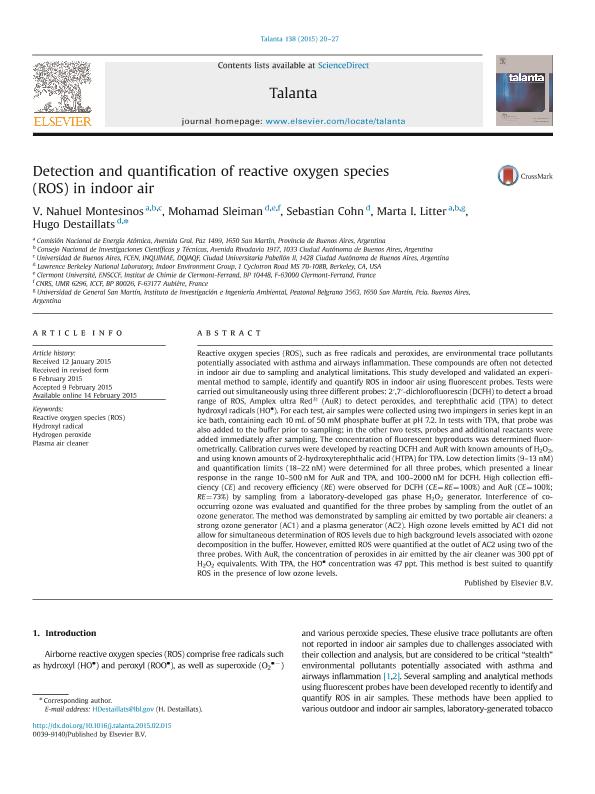Mostrar el registro sencillo del ítem
dc.contributor.author
Montesinos, Victor Nahuel

dc.contributor.author
Sleiman, Mohamad
dc.contributor.author
Cohn, Sebastian
dc.contributor.author
Litter, Marta Irene

dc.contributor.author
Destaillats, Hugo

dc.date.available
2020-08-25T20:19:13Z
dc.date.issued
2015-06
dc.identifier.citation
Montesinos, Victor Nahuel; Sleiman, Mohamad ; Cohn, Sebastian ; Litter, Marta Irene; Destaillats, Hugo; Detection and quantification of reactive oxygen species (ROS) in indoor air; Elsevier Science; Talanta; 138; 6-2015; 20-27
dc.identifier.issn
0039-9140
dc.identifier.uri
http://hdl.handle.net/11336/112403
dc.description.abstract
Reactive oxygen species (ROS), such as free radicals and peroxides, are environmental trace pollutants potentially associated with asthma and airways inflammation. These compounds are often not detected in indoor air due to sampling and analytical limitations. This study developed and validated an experimental method to sample, identify and quantify ROS in indoor air using fluorescent probes. Tests were carried out simultaneously using three different probes: 2′,7′-dichlorofluorescin (DCFH) to detect a broad range of ROS, Amplex ultra Red® (AuR) to detect peroxides, and terephthalic acid (TPA) to detect hydroxyl radicals (HO•). For each test, air samples were collected using two impingers in series kept in an ice bath, containing each 10 mL of 50 mM phosphate buffer at pH 7.2. In tests with TPA, that probe was also added to the buffer prior to sampling; in the other two tests, probes and additional reactants were added immediately after sampling. The concentration of fluorescent byproducts was determined fluorometrically. Calibration curves were developed by reacting DCFH and AuR with known amounts of H2O2, and using known amounts of 2-hydroxyterephthalic acid (HTPA) for TPA. Low detection limits (9-13 nM) and quantification limits (18-22 nM) were determined for all three probes, which presented a linear response in the range 10-500 nM for AuR and TPA, and 100-2000 nM for DCFH. High collection efficiency (CE) and recovery efficiency (RE) were observed for DCFH (CE=RE=100%) and AuR (CE=100%; RE=73%) by sampling from a laboratory-developed gas phase H2O2 generator. Interference of co-occurring ozone was evaluated and quantified for the three probes by sampling from the outlet of an ozone generator. The method was demonstrated by sampling air emitted by two portable air cleaners: a strong ozone generator (AC1) and a plasma generator (AC2). High ozone levels emitted by AC1 did not allow for simultaneous determination of ROS levels due to high background levels associated with ozone decomposition in the buffer. However, emitted ROS were quantified at the outlet of AC2 using two of the three probes. With AuR, the concentration of peroxides in air emitted by the air cleaner was 300 ppt of H2O2 equivalents. With TPA, the HO• concentration was 47 ppt. This method is best suited to quantify ROS in the presence of low ozone levels.
dc.format
application/pdf
dc.language.iso
eng
dc.publisher
Elsevier Science

dc.rights
info:eu-repo/semantics/openAccess
dc.rights.uri
https://creativecommons.org/licenses/by-nc-sa/2.5/ar/
dc.subject
HYDROGEN PEROXIDE
dc.subject
HYDROXYL RADICAL
dc.subject
PLASMA AIR CLEANER
dc.subject
REACTIVE OXYGEN SPECIES (ROS)
dc.subject.classification
Físico-Química, Ciencia de los Polímeros, Electroquímica

dc.subject.classification
Ciencias Químicas

dc.subject.classification
CIENCIAS NATURALES Y EXACTAS

dc.title
Detection and quantification of reactive oxygen species (ROS) in indoor air
dc.type
info:eu-repo/semantics/article
dc.type
info:ar-repo/semantics/artículo
dc.type
info:eu-repo/semantics/publishedVersion
dc.date.updated
2020-08-25T15:18:18Z
dc.journal.volume
138
dc.journal.pagination
20-27
dc.journal.pais
Países Bajos

dc.journal.ciudad
Amsterdam
dc.description.fil
Fil: Montesinos, Victor Nahuel. Comisión Nacional de Energía Atómica. Gerencia del Área de Seguridad Nuclear y Ambiente. Gerencia de Química (CAC); Argentina. Consejo Nacional de Investigaciones Científicas y Técnicas. Oficina de Coordinación Administrativa Ciudad Universitaria. Instituto de Química, Física de los Materiales, Medioambiente y Energía. Universidad de Buenos Aires. Facultad de Ciencias Exactas y Naturales. Instituto de Química, Física de los Materiales, Medioambiente y Energía; Argentina
dc.description.fil
Fil: Sleiman, Mohamad. Clermont Université; Francia. Lawrence Berkeley National Laboratory. Environmental Energy Technologies División. Indoor Environment Group; Estados Unidos. Centre National de la Recherche Scientifique; Francia
dc.description.fil
Fil: Cohn, Sebastian. Lawrence Berkeley National Laboratory. Environmental Energy Technologies División. Indoor Environment Group; Estados Unidos
dc.description.fil
Fil: Litter, Marta Irene. Universidad Nacional de San Martín. Instituto de Investigación en Ingeniería Ambiental; Argentina. Consejo Nacional de Investigaciones Científicas y Técnicas; Argentina. Comisión Nacional de Energía Atómica. Gerencia del Área de Seguridad Nuclear y Ambiente. Gerencia de Química (CAC); Argentina
dc.description.fil
Fil: Destaillats, Hugo. Lawrence Berkeley National Laboratory. Environmental Energy Technologies División. Indoor Environment Group; Estados Unidos
dc.journal.title
Talanta

dc.relation.alternativeid
info:eu-repo/semantics/altIdentifier/url/http://linkinghub.elsevier.com/retrieve/pii/S0039914015000971
dc.relation.alternativeid
info:eu-repo/semantics/altIdentifier/doi/http://dx.doi.org/10.1016/j.talanta.2015.02.015
Archivos asociados
